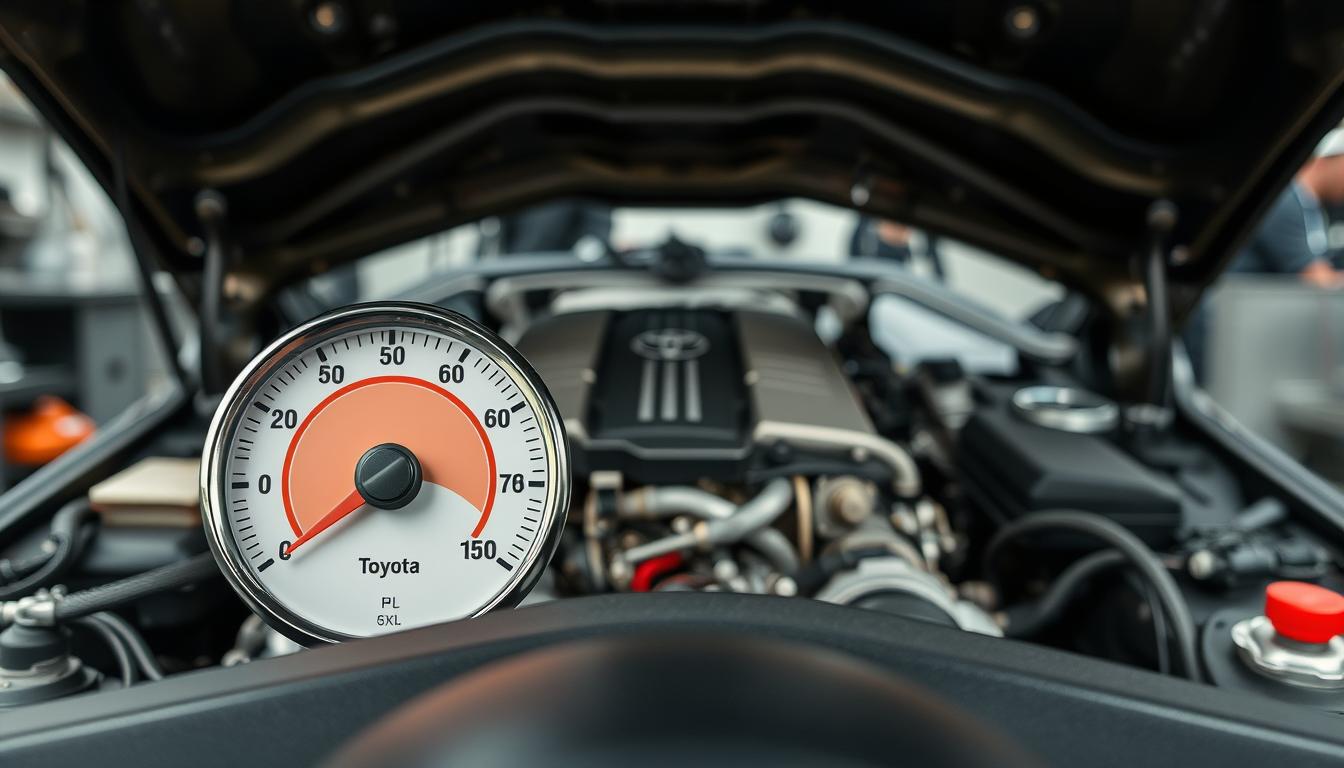Keeping your car’s engine temperature just right is key to its health and performance. When the temperature is perfect, your car drives smoothly. This also lowers the chance of engine damage.
Good engine temperature means better fuel use and less pollution. We’ll dive into why engine temperature maintenance is vital. Plus, we’ll share ways to keep your Toyota engine at the right temperature.
Understanding Engine Temperature in Toyota Vehicles
The engine temperature of your Toyota is key to its performance and life. Knowing when it’s overheating is important. Look for signs on the dashboard’s temperature gauge.
Why Engine Temperature Matters
Engine temperature is vital for your Toyota’s health. Overheating can cause expensive damage to the engine. Experts say a well-tempered engine runs better, uses less fuel, and pollutes less.
Keeping the engine at the right temperature is important. It helps the oil work better and reduces wear. It also ensures the engine burns fuel efficiently, keeping it healthy.
How Toyota Engines Manage Heat
Toyota engines have a smart cooling system to handle heat. This system includes a radiator, water pump, thermostat, and coolant. The thermostat is key in controlling coolant flow, helping the engine reach its best temperature.
Keeping the cooling system in top shape is critical. It helps avoid overheating and keeps your engine running smoothly. Regular checks and maintenance are a must.
Normal Toyota Engine Temperature Ranges
Knowing the normal temperature range for your Toyota engine is key to keeping it in top shape. Toyota engines are built to work best within certain temperature ranges. This ensures they run efficiently and last longer.
Cold Start Temperature Readings
When you start your Toyota engine, the temperature gauge on your dashboard will show a lower reading. As it warms up, the temperature will go up. It’s normal for the temperature to change a bit during this time. The engine temperature sensor is important in watching these temperature changes.
Optimal Operating Temperature
Most Toyota engines work best between 195°F and 220°F (90°C to 104°C). Keeping the engine in this range is key for the best performance and fuel use. The cooling system helps keep the engine at the right temperature, even when driving conditions change.
Temperature Variations by Toyota Model
Toyota models can have different optimal engine temperature ranges. This is because of differences in engine design and cooling systems. For example, some high-performance models might run at slightly higher temperatures. Always check your owner’s manual or talk to a Toyota dealership to find out the right temperature range for your car.

- Coolant level and condition
- Thermostat operation
- Radiator and fan functionality
- Driving conditions (e.g., traffic, weather)
By knowing these factors and keeping an eye on your engine’s temperature, you can help your Toyota run smoothly and efficiently.
Components of Toyota’s Cooling System
Toyota’s engine cooling system keeps the engine at the right temperature. It uses many important parts to do this. This system is key to keeping the engine running well and lasting long.
Radiator and Its Function
The radiator is a main part of Toyota’s cooling system. It helps get rid of heat from the coolant. It does this by moving coolant through its core, where the heat goes to the air.
Efficient heat dissipation is key to keeping the engine at the best temperature.
Water Pump and Coolant Flow
The water pump is important for moving coolant around the engine. It makes sure heat moves from the engine to the radiator. If the water pump doesn’t work right, the engine might get too hot.
Thermostat Operation
The thermostat helps control the engine’s temperature by managing coolant flow. It opens and closes based on temperature, helping the engine get to its best temperature fast. A working thermostat is vital for engine temperature maintenance.
In short, Toyota’s cooling system parts work together to keep the engine at the right temperature. Keeping these parts in good shape is key to avoiding overheating and making the engine last longer.
Toyota Engine Temperature: Monitoring and Importance
It’s key to keep an eye on your Toyota’s engine temperature. The dashboard temperature gauge is a vital tool for this. It shows the engine’s temperature in real-time.
Dashboard Temperature Gauge Explained
The dashboard temperature gauge is found on the instrument cluster. It shows the engine’s coolant temperature. A normal temperature is when the needle is in the middle.
If the needle goes to the hot side, it might mean a cooling system problem. Drivers should know:
- What temperature range is normal for their Toyota model
- What warning signs of overheating look like, like the needle in the red zone
- The need to check the gauge often, even in extreme weather
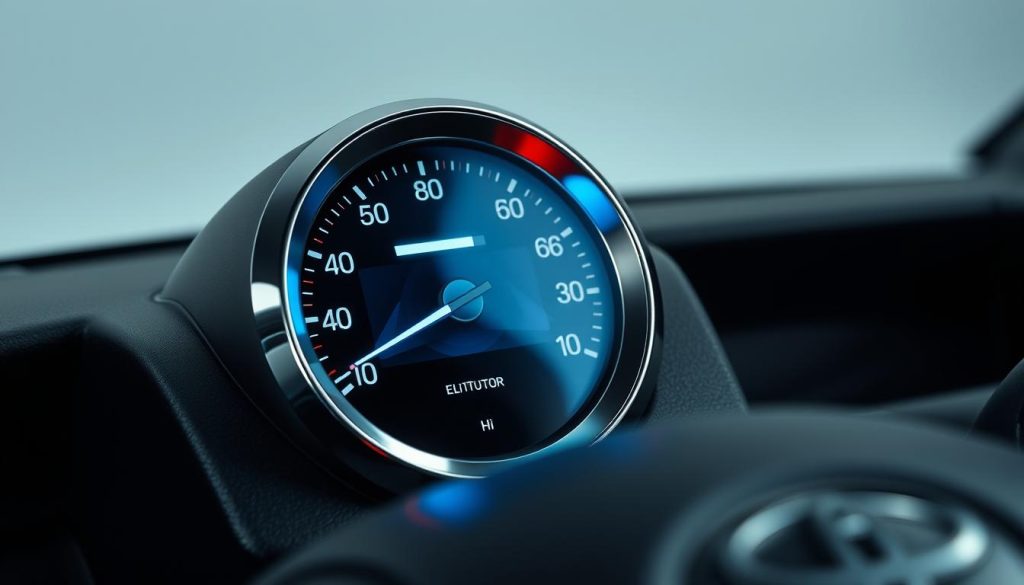
Impact on Engine Longevity
Ignoring engine temperature can cause early wear and damage. Keeping the engine at the right temperature is key for:
- Stopping overheating, which can be very expensive
- Keeping the engine well-lubricated and reducing wear
- Keeping fuel efficiency and engine performance up
By watching the dashboard temperature gauge closely, Toyota owners can make their engine last longer. This helps avoid costly repairs later.
Common Causes of Toyota Engine Overheating
Knowing why engines overheat is key for Toyota owners. It helps avoid expensive fixes and keeps the car running well. Overheating can damage the engine, leading to costly repairs. Spotting these problems early can save a lot of money and time.
Low Coolant Levels
Low coolant is a big reason for overheating in Toyotas. Coolant keeps the engine cool. If it’s too low, the engine gets too hot. Always check the coolant level and look for leaks in the cooling system.
Faulty Water Pump
A bad water pump can also cause overheating. It moves coolant through the engine. If it breaks down, the engine can’t cool down properly. Look for leaks, strange noises, and dirty coolant to spot a failing pump.
Radiator Issues
The radiator is key to cooling the engine. Clogs, leaks, or corrosion can stop it from working. Regular checks and maintenance can prevent overheating. Make sure the radiator cap is working right to keep pressure in the system.
Thermostat Failures
A bad thermostat can also cause overheating. It controls how hot the engine gets. If it’s stuck, the engine can’t cool down. Or, if it’s always open, the engine won’t run right.
| Cause | Description | Symptoms |
|---|---|---|
| Low Coolant Levels | Insufficient coolant to regulate engine temperature. | Overheating, coolant leaks. |
| Faulty Water Pump | Water pump failure to circulate coolant. | Leaks, unusual noises, coolant contamination. |
| Radiator Issues | Clogs, leaks, or corrosion in the radiator. | Overheating, radiator leaks. |
| Thermostat Failures | Thermostat stuck closed or open. | Overheating, poor engine performance. |
Knowing these common causes helps Toyota owners keep their cars running well. Regular checks and maintenance are important. They help keep the engine cool and prevent big problems.
Warning Signs of Engine Temperature Problems
It’s important to know the warning signs of engine temperature issues. These problems can cause serious damage if not fixed quickly.
There are several key indicators that your Toyota’s engine temperature is not within the normal range. Being aware of these signs can help you take corrective action before more severe damage occurs.
Dashboard Warning Lights
The temperature warning light on your dashboard is a clear sign. It means the engine temperature has gone too high. If this light comes on, pull over safely and turn off the engine to prevent further damage.
Steam from Engine Bay
Visible steam or smoke from the engine bay is another critical warning sign. It could mean a coolant leak or other issues causing the engine to overheat. If you notice steam, stop your vehicle immediately and investigate the cause.
Performance Changes
Changes in your vehicle’s performance can also signal engine temperature problems. Symptoms might include a decrease in power, hesitation, or unusual noises. These changes can occur when the engine is not operating within its optimal temperature range.
| Warning Sign | Description | Action |
|---|---|---|
| Dashboard Warning Light | Temperature warning light illuminates | Pull over and turn off the engine |
| Steam from Engine Bay | Visible steam or smoke | Stop and investigate the cause |
| Performance Changes | Decrease in power, hesitation, or unusual noises | Check engine temperature and coolant level |
How to Check Your Toyota Engine Temperature
It’s important to check your Toyota’s engine temperature regularly. This helps keep your car running well and prevents big problems.
Using the Dashboard Gauge
The dashboard temperature gauge is easy to use. It’s on the instrument cluster and shows the engine’s temperature. Watch the gauge; if it goes into the red, it might be too hot.
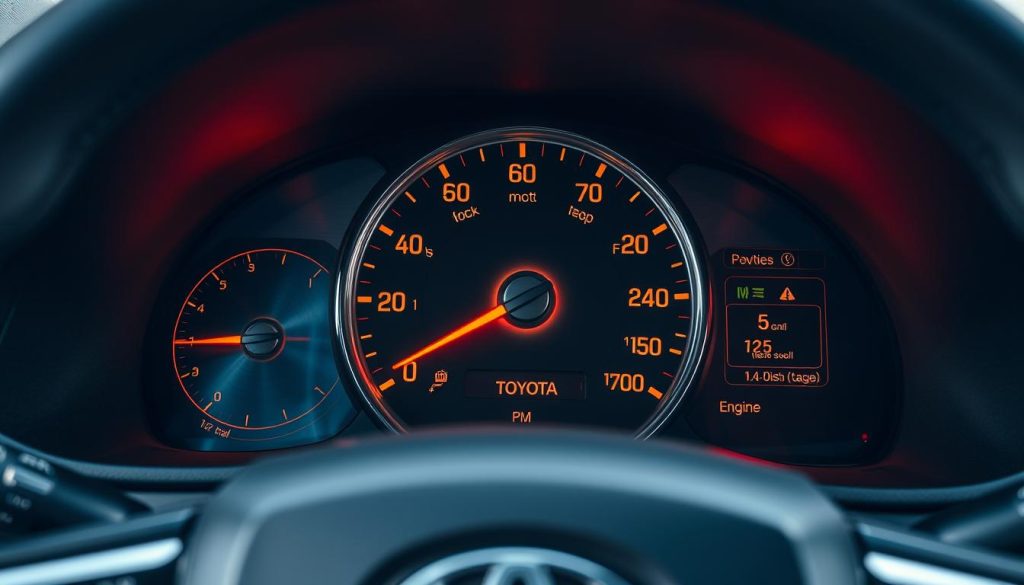
OBD-II Scanner Methods
An OBD-II scanner gives you a precise reading. It connects to your car’s computer and shows engine details, like temperature. With an OBD-II scanner, you get real-time data to track temperature changes.
Manual Temperature Checks
Sometimes, you need to check manually. Look for leaks or damage in the cooling system and check the coolant level. Regular maintenance helps avoid temperature problems. Make sure the coolant is at the right level and there are no leaks.
Using these methods, you can keep an eye on your Toyota’s engine temperature. This way, you can take care of your car and keep it running smoothly.
Toyota Engine Temperature Sensor: Function and Maintenance
Knowing how the Toyota engine temperature sensor works is key to keeping your car in top shape. This sensor is vital for watching the engine’s temperature. It makes sure the engine stays at the right temperature.
How the Temperature Sensor Works
The engine temperature sensor in Toyotas checks the engine coolant’s temperature. It sends this info to the engine control unit (ECU). The ECU then tweaks the engine’s performance to avoid overheating.
This is important for keeping fuel use down and preventing engine harm.
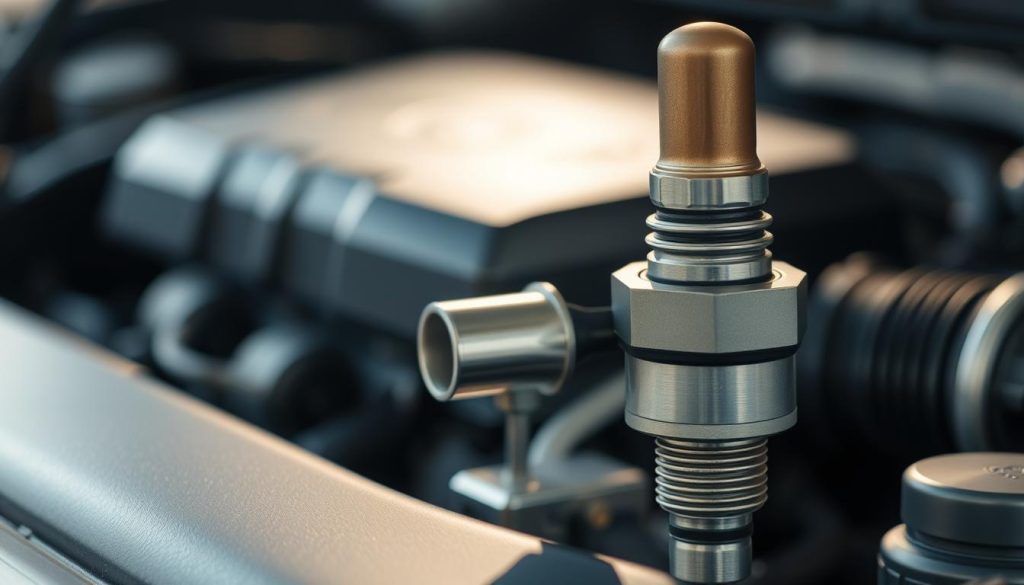
Signs of a Failing Sensor
A bad engine temperature sensor can lead to several problems. These include wrong temperature readings, engine overheating, and less fuel efficiency. If you spot any of these signs, it’s time to check the sensor.
Common signs include:
- Dashboard warning lights
- Erratic temperature gauge readings
- Engine performance issues
Replacing the Temperature Sensor
Replacing the engine temperature sensor is easy. First, find the sensor, usually near the thermostat housing. Then, disconnect the electrical connector and take out the sensor. Putting in a new one is the reverse of this.
It’s important to look at your Toyota’s repair manual for exact steps.
| Sensor Condition | Symptoms | Action |
|---|---|---|
| Failing Sensor | Inaccurate temperature readings, engine overheating | Inspect and replace if necessary |
| Faulty Electrical Connector | Intermittent sensor readings | Check and repair/replace connector |
Step-by-Step Troubleshooting for Temperature Issues
Fixing engine temperature problems in your Toyota is easy if you know how. Start by checking the cooling system parts to find the problem.
Checking for Coolant Leaks
First, look for coolant leaks. Check the hoses, radiator, and water pump for leaks. Look for green or yellow fluid under the car or near these parts. If you see a leak, it might be why your engine is too hot.
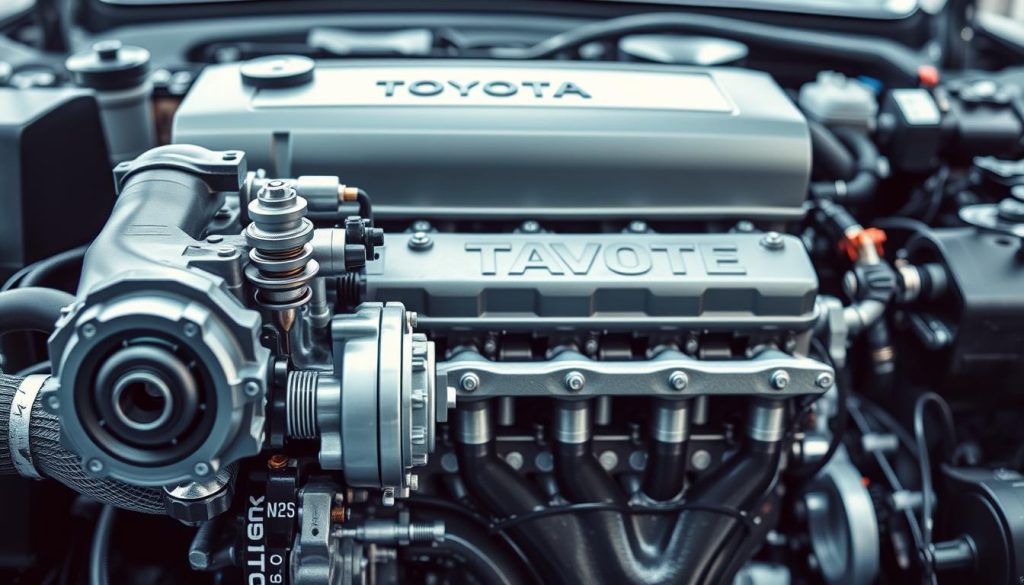
Testing the Thermostat
A bad thermostat can mess with your engine’s temperature. Find the thermostat housing. Remove the thermostat and test it in boiling water. If it doesn’t open, it’s broken and needs a new one.
Inspecting the Radiator Cap
The radiator cap keeps the cooling system’s pressure right. Check the cap for wear or damage. A damaged cap can cause coolant loss and overheating. Make sure it seals well and doesn’t let coolant out.
Examining the Water Pump
The water pump keeps coolant moving through the engine. Look for leaks or failure signs. Listen for unusual noises from the pump. If it’s not working right, you might need a new one.
By following these steps, you can find and fix engine temperature problems in your Toyota. Always check your repair manual for the right steps and safety tips.
Preventative Maintenance for Toyota Cooling Systems
Preventative maintenance is key to avoiding expensive repairs for your Toyota’s cooling system. Regular checks and upkeep can greatly extend your engine’s life and prevent overheating.
Checking and changing coolant regularly is a must. Coolant can break down over time, losing its effectiveness and potentially harming your engine.
Regular Coolant Checks and Changes
Always check your coolant level and add more as needed. Also, change the coolant as your owner’s manual suggests, usually every 30,000 to 50,000 miles.
Using the right coolant for your Toyota is important, as your owner’s manual will tell you.
Inspecting Hoses and Belts
It’s important to check the hoses and belts in your cooling system. Look for any signs of wear, cracks, or leaks. Replace any damaged parts right away.
A broken belt or a leaking hose can cause your engine to overheat. This can lead to serious damage.
Radiator Maintenance
The radiator is a key part of your Toyota’s cooling system. Regularly check it for leaks or corrosion.
Make sure the radiator cap is in good shape and works right. A bad cap can cause coolant to leak out.
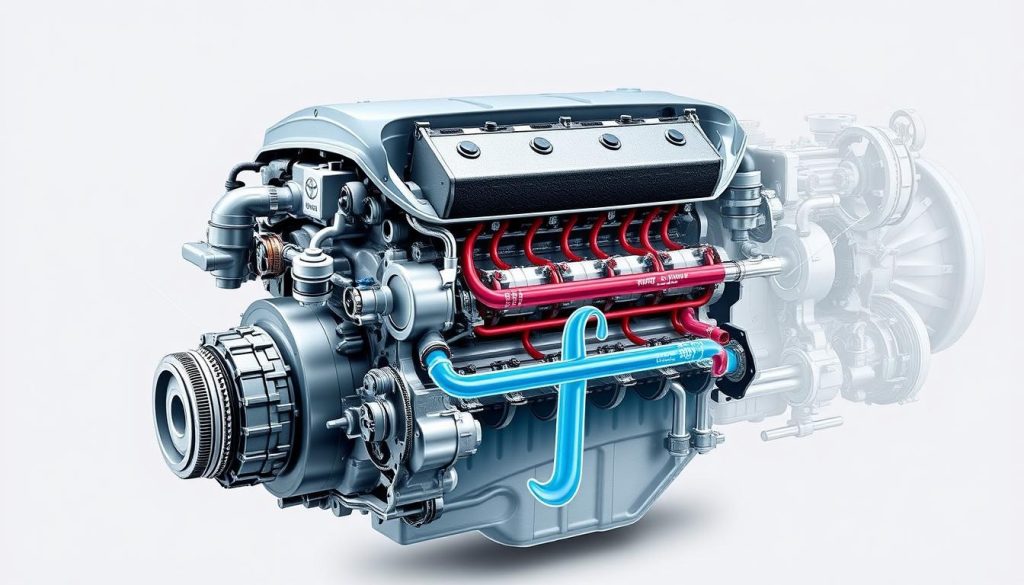
By following these tips, you can keep your Toyota’s cooling system running smoothly. This prevents overheating and helps your engine last longer.
| Maintenance Task | Frequency | Importance |
|---|---|---|
| Coolant Check | Regularly | High |
| Coolant Change | Every 30,000 to 50,000 miles | High |
| Hoses and Belts Inspection | Regularly | High |
| Radiator Inspection | Regularly | High |
Regular maintenance not only saves you money but also keeps your Toyota running well. It helps with fuel efficiency and keeps your car performing at its best.
Step-by-Step Guide to Coolant Flush for Toyota Engines
Keeping your Toyota’s engine cooling system in top shape is key. A coolant flush is a great way to do this. It helps keep the engine temperature right and prevents damage. You’ll need to drain the old coolant, flush the system, and fill it with new coolant.
Tools and Materials Needed
First, get the tools and materials ready. You’ll need a socket wrench or ratchet, a drain pan, new coolant, and a funnel. Always check your owner’s manual for specific steps and safety tips.
| Tool/Material | Description |
|---|---|
| Socket wrench or ratchet | For loosening the drain valve |
| Drain pan | For catching the old coolant |
| New coolant | Compatible with your Toyota model |
| Funnel | For pouring in the new coolant |
Draining the Old Coolant
Start by finding the drain valve at the radiator’s bottom. Use a socket wrench or ratchet to open it. Be careful, as the coolant is hot and under pressure. Once drained, close the valve tightly.
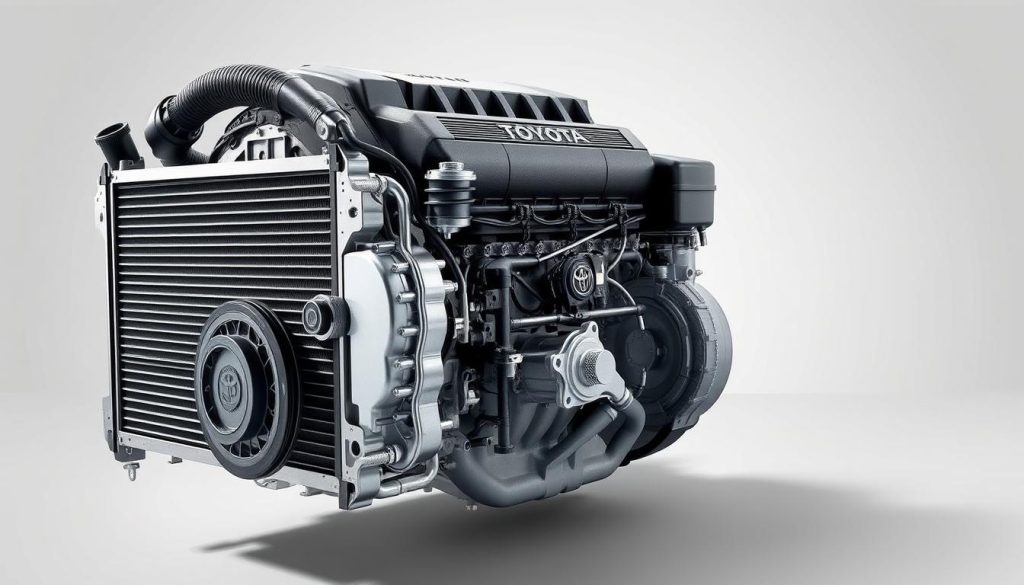
Flushing the System and Adding Fresh Coolant
Next, flush the system. This means running a cleaning solution or water through the engine. This removes any dirt or old coolant. Then, add fresh coolant that matches your Toyota model.
To flush, you can use a cooling system flush kit or water. Follow the instructions to circulate the solution. After flushing, drain and refill with new coolant.
When adding new coolant, use a funnel. Make sure to follow the manufacturer’s guidelines for type and amount. After refilling, start the engine and check for leaks.
Emergency Measures for an Overheating Toyota Engine
If your Toyota engine overheats, it’s important to stay calm and act quickly. An overheating engine can cause serious damage if not fixed fast.
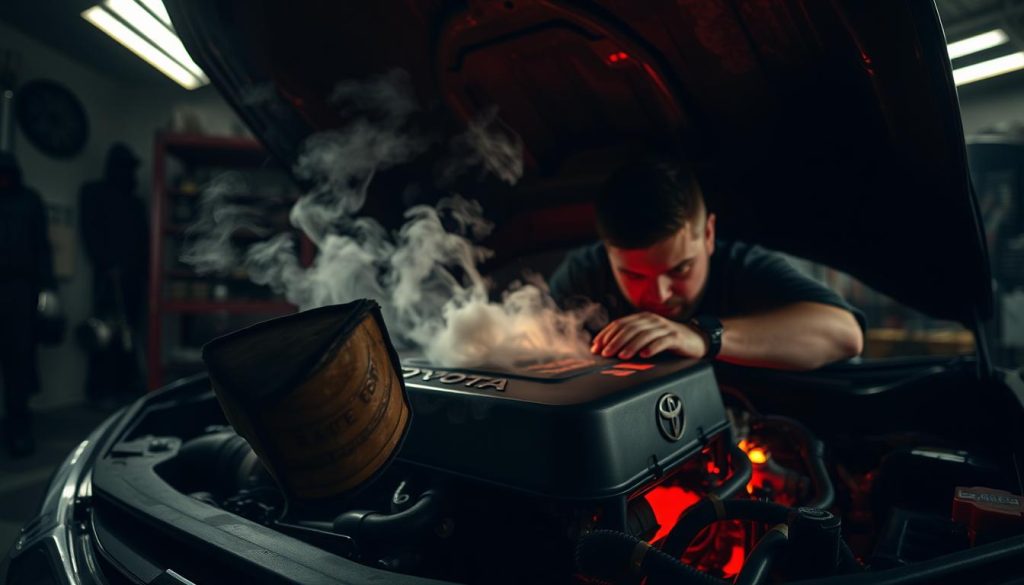
Immediate Actions to Take
First, pull over to a safe spot as soon as your Toyota’s engine starts to overheat. Turn off the engine and let it cool down. Also, check the coolant level and look for any leaks.
- Pull over to a safe location immediately
- Turn off the engine
- Check the coolant level
- Inspect for signs of coolant leaks
A study by the Automotive Research Association shows that regular maintenance can lower the risk of engine overheating. So, keeping your Toyota’s cooling system in top shape is key.
What Not to Do When Overheating
When your Toyota engine overheats, there are things you should not do. Never remove the radiator cap when the engine is hot, as it can cause burns. Also, don’t keep driving with an overheating engine, as it can lead to expensive repairs.
| Action | Consequence |
|---|---|
| Removing radiator cap when hot | Severe burns |
| Continuing to drive when overheating | Costly engine damage |
Toyota’s maintenance guide stresses the importance of proper care and timely actions to avoid overheating. By following these tips, Toyota owners can reduce the risk of engine damage.
Engine Temperature and Fuel Efficiency in Toyotas
Keeping the engine at the right temperature is key for better fuel efficiency in Toyotas. When the engine is at its ideal temperature, it uses fuel more efficiently. This results in better mileage and lower emissions.
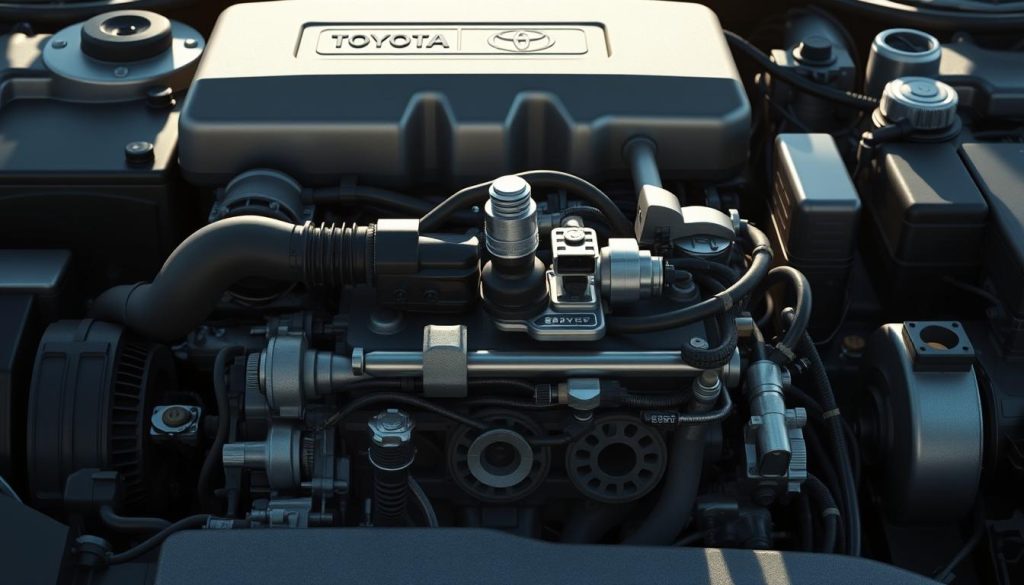
How Temperature Affects Fuel Consumption
Engine temperature greatly affects how much fuel is used. A cold engine uses more fuel because it hasn’t warmed up yet. The U.S. Department of Energy found that a cold engine can use up to 20% more fuel than a warm one.
As the engine warms up, it starts to use fuel more efficiently. But, an engine that’s too hot can also use more fuel. This is because the engine management system makes changes to prevent damage.
Key factors influencing fuel consumption due to engine temperature include:
- Engine warm-up time
- Coolant temperature
- Thermostat operation
Maintaining Optimal Temperature for Efficiency
To keep your engine at the right temperature and improve fuel efficiency, regular maintenance is a must. This includes checking the coolant level, looking at the thermostat, and making sure the radiator is working well. As Toyota advises, “regular coolant changes help keep your engine’s cooling system healthy.”
“Regular maintenance of your Toyota’s cooling system is key for keeping the engine at the right temperature and fuel efficiency.” –
By keeping your Toyota’s engine at the right temperature, you’ll enjoy better fuel economy and a longer engine life.
Toyota-Specific Cooling System Features
Toyota has developed special features for its engine cooling systems. These features improve how well the car runs. They focus on hybrid and VVT-i engine technologies.
Toyota Hybrid System Cooling
The hybrid system in Toyota cars aims to save fuel and cut down on pollution. The cooling system is key to keeping the engine and electric motor at the right temperature. This ensures the hybrid system works best, saving fuel and reducing wear on parts.
VVT-i Engine Cooling Considerations
VVT-i engines use advanced cooling systems for better temperature control. This is important for the engine’s performance and efficiency. The cooling system adjusts to different driving conditions, helping the engine last longer.
Toyota’s Approach to Thermal Management
Toyota uses a detailed cooling strategy in its cars. It includes using new materials and designs to better handle heat. This approach helps keep the car running well and reliably.
| Cooling System Feature | Description | Benefit |
|---|---|---|
| Hybrid System Cooling | Optimized cooling for hybrid engines and electric motors | Enhanced fuel efficiency and reduced emissions |
| VVT-i Engine Cooling | Advanced temperature control for VVT-i engines | Improved engine performance and longevity |
| Thermal Management | Comprehensive cooling strategy using advanced materials | Consistent performance and reliability across models |
When to Seek Professional Help for Engine Temperature Problems
Dealing with engine temperature issues can be tough on your own. It’s key to know when to get help from a pro. Some problems are easy to fix, but others need a skilled technician.
Symptoms Requiring Immediate Attention
Watch out for these signs and get help right away:
- Persistent Overheating: If your Toyota engine keeps overheating, even after checking the coolant, it’s a red flag.
- Coolant Leaks: Coolant leaks around the engine or hoses mean you need to act fast.
- Unusual Temperature Fluctuations: Sudden engine temperature changes could mean a serious problem.
Ignoring these signs can cost you a lot or even damage your engine. So, it’s important to fix them quickly.
Finding a Qualified Toyota Technician
Finding the right technician is key. Here’s how to find one:
- Look for Certified Technicians: Toyota-certified techs know how to fix Toyota engine problems.
- Check Reviews and Ratings: Online reviews can tell you about a technician’s reputation.
- Ask for Referrals: Ask people you trust for recommendations on good technicians.
Choosing a qualified technician ensures your Toyota gets the best care for engine issues.
Conclusion: Ensuring Your Toyota Stays Cool for Years to Come
Keeping your Toyota engine temperature just right is key for your car’s health and performance. We’ve looked at how to manage engine temperature, from knowing what’s normal to fixing common problems.
By sticking to the advice in this article, you can keep your Toyota at the perfect temperature. This boosts its performance and saves fuel. Regular engine temperature maintenance stops overheating and helps your engine last longer.
As a Toyota owner, using what you’ve learned here will keep your car running well. Make sure to check your cooling system often and watch out for any warning signs. This way, your Toyota will stay cool and run great for many years.
FAQ
What is the normal operating temperature for a Toyota engine?
A Toyota engine usually runs between 195°F and 220°F. This depends on the model and how you drive it.
How do I check my Toyota’s engine temperature?
You can use the dashboard gauge, an OBD-II scanner, or a thermometer to check your Toyota’s engine temperature.
What are the common causes of engine overheating in Toyota vehicles?
Engine overheating in Toyotas can be due to low coolant, a bad water pump, radiator problems, or a faulty thermostat.
How often should I change my Toyota’s coolant?
Change your Toyota’s coolant every 30,000 to 50,000 miles. This depends on your model and driving habits.
What are the warning signs of engine temperature problems in Toyota vehicles?
Look out for dashboard lights, steam or smoke from the engine, and changes in how your car drives.
Can a faulty engine temperature sensor cause problems?
Yes, a bad temperature sensor can lead to wrong readings, poor engine performance, and even damage.
How do I troubleshoot engine temperature issues in my Toyota?
To fix engine temperature problems, check for coolant leaks, test the thermostat, and look at the radiator cap and water pump.
What is the role of the thermostat in Toyota’s cooling system?
The thermostat controls the coolant flow to keep the engine at the right temperature.
How does Toyota’s hybrid system cooling work?
Toyota’s hybrid cooling manages the battery and other parts’ temperatures. This ensures they work well and last long.
What are the benefits of maintaining optimal engine temperature in Toyota vehicles?
Keeping the engine at the right temperature boosts fuel efficiency, cuts emissions, and extends engine life.
When should I seek professional help for engine temperature problems?
Get professional help if you see overheating, coolant leaks, or unusual temperature changes. Or if you’re not sure what to do.
